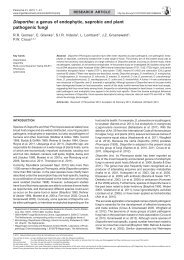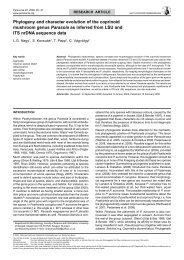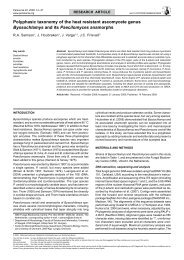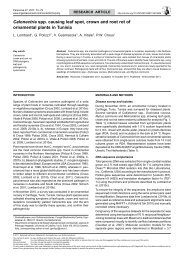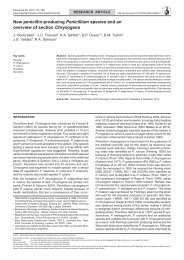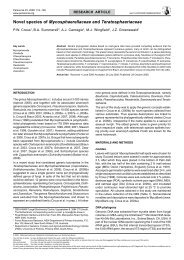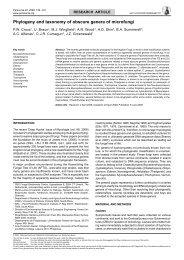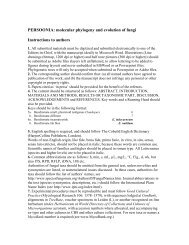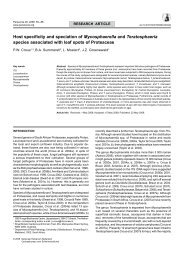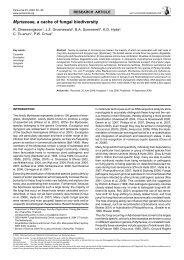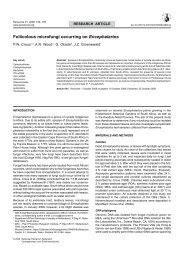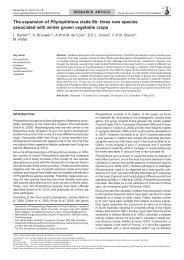Calonectria (Cylindrocladium) species associated with ... - Persoonia
Calonectria (Cylindrocladium) species associated with ... - Persoonia
Calonectria (Cylindrocladium) species associated with ... - Persoonia
You also want an ePaper? Increase the reach of your titles
YUMPU automatically turns print PDFs into web optimized ePapers that Google loves.
<strong>Persoonia</strong> 23, 2009: 41–47<br />
www.persoonia.org<br />
RESEARCH ARTICLE<br />
doi:10.3767/003158509X471052<br />
<strong>Calonectria</strong> (<strong>Cylindrocladium</strong>) <strong>species</strong> <strong>associated</strong> <strong>with</strong><br />
dying Pinus cuttings<br />
L. Lombard 1 , C.A. Rodas 1 , P.W. Crous 1,3 , B.D. Wingfield 2 , M.J. Wingfield 1<br />
Key words<br />
β-tubulin<br />
<strong>Calonectria</strong><br />
<strong>Cylindrocladium</strong><br />
histone<br />
Pinus<br />
root disease<br />
Abstract <strong>Calonectria</strong> (Ca.) <strong>species</strong> and their <strong>Cylindrocladium</strong> (Cy.) anamorphs are well-known pathogens of forest<br />
nursery plants in subtropical and tropical areas of the world. An investigation of the mortality of rooted Pinus cuttings<br />
in a commercial forest nursery in Colombia led to the isolation of two <strong>Cylindrocladium</strong> anamorphs of <strong>Calonectria</strong> <strong>species</strong>.<br />
The aim of this study was to identify these <strong>species</strong> using DNA sequence data and morphological comparisons.<br />
Two <strong>species</strong> were identified, namely one undescribed <strong>species</strong>, and Cy. gracile, which is allocated to <strong>Calonectria</strong><br />
as Ca. brassicae. The new <strong>species</strong>, Ca. brachiatica, resides in the Ca. brassicae <strong>species</strong> complex. Pathogenicity<br />
tests <strong>with</strong> Ca. brachiatica and Ca. brassicae showed that both are able to cause disease on Pinus maximinoi and<br />
P. tecunumanii. An emended key is provided to distinguish between <strong>Calonectria</strong> <strong>species</strong> <strong>with</strong> clavate vesicles and<br />
1-septate macroconidia.<br />
Article info Received: 8 April 2009; Accepted: 16 July 2009; Published: 12 August 2009.<br />
Introduction<br />
Species of <strong>Calonectria</strong> (anamorph <strong>Cylindrocladium</strong>) are plant<br />
pathogens <strong>associated</strong> <strong>with</strong> a large number of agronomic and<br />
forestry crops in temperate, subtropical and tropical climates,<br />
worldwide (Crous & Wingfield 1994, Crous 2002). Infection by<br />
these fungi gives rise to symptoms including cutting rot (Crous<br />
et al. 1991), damping-off (Sharma et al. 1984, Ferreira et al.<br />
1995), leaf spot (Sharma et al. 1984, Ferreira et al. 1995, Crous<br />
et al. 1998), shoot blight (Crous et al. 1991, Crous et al. 1998),<br />
stem cankers (Sharma et al. 1984, Crous et al. 1991) and root<br />
disease (Mohanan & Sharma 1985, Crous et al. 1991) on various<br />
forest trees <strong>species</strong>.<br />
The first report of Ca. morganii (as Cy. scoparium) infecting<br />
Pinus spp. was by Graves (1915), but he failed to re-induce<br />
disease symptoms and assumed that it was a saprobe. There<br />
have subsequently been several reports of <strong>Cylindrocladium</strong> spp.<br />
infecting Pinus and other conifers, leading to root rot, stem cankers<br />
and needle blight (Jackson 1938, Cox 1953, Thies & Patton<br />
1970, Sobers & Alfieri 1972, Cordell & Skilling 1975, Darvas et<br />
al. 1978, Crous et al. 1991, Crous 2002). Most of these reports<br />
implicated Ca. morganii and Ca. pteridis (as Cy. macrosporum<br />
or Cy. pteridis) as the primary pathogens (Thies & Patton 1970,<br />
Ahmad & Ahmad 1982). However, as knowledge of these fungi<br />
has grown, together <strong>with</strong> refinement of their taxonomy applying<br />
DNA sequence comparisons (Crous et al. 2004, 2006), several<br />
additional <strong>Cylindrocladium</strong> spp. have been identified as causal<br />
agents of disease on different conifer <strong>species</strong>. These include<br />
Ca. acicola, Ca. colhounii, Ca. kyotensis (= Cy. floridanum), Ca.<br />
pteridis, Cy. canadense, Cy. curvisporum, Cy. gracile and Cy.<br />
pacificum (Hodges & May 1970, Crous 2002, Gadgill & Dick<br />
2004, Taniguchi et al. 2008).<br />
1<br />
Department of Microbiology and Plant Pathology, Tree Protection Co-operative<br />
Programme, Forestry and Agricultural Biotechnology Institute, University<br />
of Pretoria, Pretoria 0002, South Africa;<br />
corresponding author e-mail: lorenzo.lombard@fabi.up.ac.za.<br />
2<br />
Department of Genetics, Forestry and Agricultural Biotechnology Institute,<br />
University of Pretoria, Pretoria 0002, South Africa.<br />
3<br />
CBS-KNAW Fungal Biodiversity Centre, Uppsalalaan 8, 3584 CT Utrecht,<br />
The Netherlands.<br />
In a recent survey, wilting, collar and root rot symptoms were<br />
observed in Colombian nurseries generating Pinus spp. from<br />
cuttings. Isolations from these diseased plants consistently<br />
yielded <strong>Cylindrocladium</strong> anamorphs of <strong>Calonectria</strong> spp., and<br />
hence the aim of this study was to identify them, and to determine<br />
if they were the causal agents of the disease in Colombian<br />
nurseries.<br />
Material and methods<br />
Isolates<br />
Pinus maximinoi and P. tecunumanii rooted cutting plants showing<br />
symptoms of collar and root rot (Fig. 1) were collected from<br />
a nursery close to Buga in Colombia. Isolations were made<br />
directly from lesions on the lower stems and roots on fusarium<br />
selective medium (FSM; Nelson et al. 1983) and malt extract<br />
agar (MEA, 2 % w/v; Biolab, Midrand, South Africa). After 5 d<br />
of incubation at 25 °C, fungal colonies of <strong>Calonectria</strong> spp. were<br />
transferred on to MEA and incubated further for 7 d. For each<br />
isolate, single conidial cultures were prepared on MEA, and<br />
representative strains are maintained in the culture collection<br />
(CMW) of the Forestry and Agricultural Biotechnology Institute<br />
(FABI), University of Pretoria, Pretoria, South Africa and the<br />
Centraalbureau voor Schimmelcultures (CBS), Utrecht, The<br />
Netherlands.<br />
Taxonomy<br />
For morphological identification of <strong>Calonectria</strong> isolates, single<br />
conidial cultures were prepared on MEA and synthetic nutrient-poor<br />
agar (SNA; Nirenburg 1981). Inoculated plates were<br />
incubated at room temperature and examined after 7 d. Gross<br />
morphological characteristics were assessed by mounting<br />
fungal structures in lactic acid. Thirty measurements at × 1 000<br />
magnification were made for each isolate. The 95 % confidence<br />
levels were determined for the pooled measurements of the<br />
respective <strong>species</strong> studied and extremes for structure sizes<br />
are given in parentheses. Optimal growth temperatures were<br />
determined between 6–36 °C at 6 °C intervals in the dark on<br />
MEA for each isolate. Colony reverse colours were determined<br />
© 2009 Nationaal Herbarium Nederland & Centraalbureau voor Schimmelcultures<br />
You are free to share - to copy, distribute and transmit the work, under the following conditions:<br />
Attribution:<br />
You must attribute the work in the manner specified by the author or licensor (but not in any way that suggests that they endorse you or your use of the work).<br />
Non-commercial: You may not use this work for commercial purposes.<br />
No derivative works: You may not alter, transform, or build upon this work.<br />
For any reuse or distribution, you must make clear to others the license terms of this work, which can be found at http://creativecommons.org/licenses/by-nc-nd/3.0/legalcode. Any of the above conditions can be<br />
waived if you get permission from the copyright holder. Nothing in this license impairs or restricts the author’s moral rights.
42 <strong>Persoonia</strong> – Volume 23, 2009<br />
a<br />
b<br />
c<br />
Fig. 1 Collar and root rot on Pinus maximinoi and P. tecunumanii. a. Girdled stem of P. maximinoi; b. exposed P. maximinoi root collar showing discolouration<br />
and resin exudation; c, d. exposed P. tecunumanii root collars showing girdling and discolouration of the cambium.<br />
d<br />
after 7 d on MEA at 24 °C in the dark, using the colour charts<br />
of Rayner (1970) for comparison.<br />
DNA phylogeny<br />
<strong>Calonectria</strong> isolates were grown on MEA for 7 d. Mycelium was<br />
then scraped from the surfaces of the cultures, freeze-dried,<br />
and ground to a powder in liquid nitrogen, using a mortar and<br />
pestle. DNA was extracted from the powdered mycelium as<br />
described by Lombard et al. (2008). A fragment of the β-tubulin<br />
gene region was amplified and sequenced using primers T1<br />
(O’Donnell & Cigelnik 1997) and CYLTUB1R (Crous et al. 2004)<br />
and a fragment for the histone H3 gene region was sequenced<br />
using primers CYLH3F and CYLH3R (Crous et al. 2004). The<br />
PCR reaction mixture used to amplify the different loci consisted<br />
of 2.5 units FastStart Taq polymerase (Roche Applied<br />
Science, USA), 10 × PCR buffer, 1–1.5 mM MgCl 2<br />
, 0.25 mM<br />
of each dNTP, 0.5 µm of each primer and approximately 30 ng<br />
of fungal genomic DNA, made up to a total reaction volume of<br />
25 µL <strong>with</strong> sterile distilled water.<br />
Amplified fragments were purified using High Pure PCR Product<br />
Purification Kit (Roche, USA) and sequenced in both directions.<br />
For this purpose, the BigDye terminator sequencing kit<br />
(v3.1, Applied Biosystems, USA) and an ABI PRISM TM 3100<br />
DNA sequencer (Applied Biosystems) were used. All PCRs<br />
and sequencing reactions were performed on an Eppendorf<br />
Mastercycler Personal PCR (Eppendorf AG, Germany) <strong>with</strong><br />
cycling conditions as described in Crous et al. (2006) for each<br />
locus. Sequences generated were added to other sequences<br />
obtained from GenBank (http://www.ncbi.nlm.nih.gov) and<br />
were assembled and aligned using Sequence Navigator v1.0.1<br />
(Applied Biosystems) and MAFFT v5.11 (Katoh et al. 2005),<br />
respectively. The aligned sequences were then manually corrected<br />
where needed. PAUP (Phylogenetic Analysis Using<br />
Parsimony, v4.0b10; Swofford 2002) was used to analyse the<br />
DNA sequence datasets. A partition homogeneity test (Farris<br />
et al. 1994) and a 70 % reciprocal bootstrap method (Mason-<br />
Gamer & Kellogg 1996) were applied to evaluate the feasibility<br />
of combining the datasets. Phylogenetic relationships were<br />
estimated by heuristic searches based on 1 000 random addition<br />
sequences and tree bisection-reconnection, <strong>with</strong> the branch<br />
swapping option set on ‘best trees’ only.<br />
All characters were weighted equally and alignment gaps were<br />
treated as missing data. Measures calculated for parsimony<br />
included tree length (TL), consistency index (CI), retention<br />
index (RI) and rescaled consistence index (RC). Bootstrap<br />
analysis (Hillis & Bull 1993) was based on 1 000 replications.<br />
All sequences for the isolates studied were analysed using the<br />
Basic Local Alignment Search Tool for Nucleotide sequences<br />
(BLASTN, Altschul et al. 1990). The phylogenetic analysis included<br />
19 partial gene sequences per gene, representing eight<br />
<strong>Calonectria</strong> spp. (Table 1) closely related to the isolates studied.<br />
<strong>Calonectria</strong> colombiensis was used as the outgroup taxon. All<br />
sequences were deposited in GenBank and the alignments in<br />
TreeBASE (http://treebase.org).<br />
A Markov Chain Monte Carlo (MCMC) algorithm was used to<br />
generate phylogenetic trees <strong>with</strong> Bayesian probabilities using<br />
MrBayes v3.1.1 (Ronquist & Huelsenbeck 2003). Models of<br />
nucleotide substitution for each gene were determined using<br />
MrModeltest (Nylander 2004) and included for each gene<br />
partition. Four MCMC chains were run simultaneously from
L. Lombard et al.: <strong>Calonectria</strong> <strong>associated</strong> <strong>with</strong> Pinus cuttings<br />
43<br />
random trees for one million generations and sampled every<br />
100 generations. The first 800 trees were discarded as the burnin<br />
phase of each analysis and posterior probabilities determined<br />
from the remaining trees.<br />
Pathogenicity tests<br />
In order to test the pathogenicity of the <strong>Calonectria</strong> spp. collected<br />
in this study, profusely sporulating isolates CMW 25293,<br />
representing Ca. brachiatica, CMW 25296 and CMW 25297,<br />
both representing Ca. brassicae, were used for inoculations<br />
onto rooted cuttings of P. maximinoi. Isolate CMW 25299, representing<br />
Ca. brassicae and isolates CMW 25302 and CMW<br />
25307 representing Ca. brachiatica were used for inoculations<br />
onto rooted cuttings of P. tecunumanii. Trees used for inoculation<br />
were between 0.5–1 m in height and 10–50 mm diam at<br />
the root collar. Trees were maintained in a greenhouse under<br />
controlled conditions prior to inoculation, so that they could<br />
become acclimatised and to ensure that they were healthy.<br />
Sixty trees for each Pinus spp. were used and an additional<br />
60 trees were used as controls. This resulted in a total of 180<br />
trees in the pathogenicity tests.<br />
Inoculations were preformed in the greenhouse by making<br />
a 5 mm diam wound on the main stems of plants <strong>with</strong> a cork<br />
borer to expose the cambium. The cambial discs were replaced<br />
<strong>with</strong> an MEA disc overgrown <strong>with</strong> the test fungi taken from 7 d<br />
old cultures. The inoculum discs were placed, mycelium side<br />
facing the cambium and the inoculation points were sealed<br />
<strong>with</strong> Parafilm to reduce contamination and desiccation. Control<br />
trees were treated in a similar fashion but inoculated <strong>with</strong> a<br />
sterile MEA plug.<br />
Six weeks after inoculation, lesion lengths on the stems of the<br />
plants were measured. The results were subsequently analysed<br />
using SAS Analytical Programmes v2002. Re-isolations were<br />
made from the edges of lesions on the test trees to ensure the<br />
presence of the inoculated fungi.<br />
Results<br />
DNA phylogeny<br />
For the β-tubulin gene region, ± 580 bases were generated<br />
for each of the isolates used in the study (Table 1). The adjusted<br />
alignment included 19 taxa <strong>with</strong> the outgroup, and 523<br />
characters including gaps after uneven ends were removed<br />
from the beginning of each sequence. Of these characters,<br />
459 were constant and uninformative. For the analysis, only<br />
the 64 parsimony informative characters were included. Parsimony<br />
analysis of the aligned sequences yielded five most<br />
parsimonious trees (TL = 231 steps; CI = 0.870; RI = 0.799;<br />
RC = 0.695; results not shown). Sequences for the histone<br />
gene region consisted of ± 460 bases for the isolates used in<br />
the study and the adjusted alignment of 19 taxa including the<br />
outgroup, consisted of 466 characters including gaps. Of these<br />
characters, 391 were excluded as constant and parsimony uninformative<br />
and 79 parsimony informative characters included.<br />
Analysis of the aligned data yielded one most parsimonious<br />
tree (TL = 290 steps; CI = 0.845; RI = 0.807; RC = 0.682;<br />
results not shown).<br />
The partition homogeneity test showed that the β-tubulin and<br />
histone dataset could be combined (P = 0.245). The 70 % reciprocal<br />
bootstrap method indicated no conflict in tree topology<br />
among the two partitions, resulting in a combined sequence<br />
dataset consisting of 993 characters including gaps for the<br />
19 taxa (including outgroup). Of these, 850 characters were<br />
constant and parsimony uninformative and excluded from the<br />
analysis. There were 143 characters in the analysis that were<br />
parsimony informative. Parsimony analysis of the combined<br />
alignments yielded one most parsimonious tree (TL = 526<br />
steps; CI = 0.848; RI = 0.791; RC = 0.670), which is presented<br />
in Fig. 2 (TreeBase SN 4332).<br />
All the isolates obtained from the Pinus spp. used in this study<br />
grouped in the Ca. brassicae <strong>species</strong> complex <strong>with</strong> a bootstrap<br />
(BP) value of 96 and a low Bayesian posterior probability (PP)<br />
of 0.70. This clade was further subdivided into two clades.<br />
The first clade (BP = 64, PP below 0.70) representing Ca.<br />
brassicae, included the type of Cy. gracile and Cy. clavatum.<br />
It also included three isolates (CMW 25297, CMW 25296 and<br />
CMW 25299) from P. maximinoi and P. tecunumanii. The second<br />
clade (BP = 98, PP = 0.82) accommodated <strong>Calonectria</strong><br />
isolates (CMW 25293, CMW 25298, CMW 25302 and CMW<br />
25307), representing what we recognise as a distinct <strong>species</strong>.<br />
The consensus tree obtained <strong>with</strong> Bayesian analysis showed<br />
topographical similarities <strong>with</strong> the most parsimonious tree as<br />
indicated in Fig. 2.<br />
Pathogenicity tests<br />
All plants inoculated <strong>with</strong> <strong>Calonectria</strong> spp. in this study developed<br />
lesions. Lesions included discolouration of the vascular<br />
tissue <strong>with</strong> abundant resin formation, 6 wk after inoculation.<br />
Table 1 Strains of <strong>Calonectria</strong> (<strong>Cylindrocladium</strong>) <strong>species</strong> included in the phylogenetic analyses (TreeBase SN 4332).<br />
Species Isolate number 1 β-tubulin 2 Histone H3 2 Host Origin Collector<br />
Ca. avesiculata (Cy. avesiculatum) CBS 313.92 T AF333392 DQ190620 Ilex vomitoria USA S.A. Alfieri<br />
Ca. brachiatica sp. nov. CMW 25293 FJ716710 FJ716714 P. maximinoi Colombia M.J. Wingfield<br />
CMW 25298 (= CBS 123700) T FJ696388 FJ696396 P. maximinoi Colombia M.J. Wingfield<br />
CMW 25302 FJ716708 FJ716712 P. tecunumanii Colombia M.J. Wingfield<br />
CMW 25307 FJ716709 FJ716713 P. tecunumanii Colombia M.J. Wingfield<br />
Ca. brassicae comb. nov. CBS 111869 T AF232857 DQ190720 Argyreia sp. South East Asia<br />
CBS 111478 DQ190611 DQ190719 Soil Brazil A.C. Alfenas<br />
CMW 25296 FJ716707 FJ716711 P. maximinoi Colombia M.J. Wingfield<br />
CMW 25297; CBS123702 FJ696387 FJ696395 P. maximinoi Colombia M.J. Wingfield<br />
CMW 25299; CBS123701 FJ696390 FJ696398 P. tecunumanii Colombia M.J. Wingfield<br />
Ca. clavata (Cy. flexuosum) CBS 114557 T AF333396 DQ190623 Callistemon viminalis USA N.E. El-Gholl<br />
CBS 114666 T DQ190549 DQ190624 USA N.E. El-Gholl<br />
Cy. clavatum (= Cy. gracile) CBS111776 T AF232850 DQ190700 Pinus caribaea Brazil C.S. Hodges<br />
Ca. colombiensis (Cy. colombiensis) CBS 12221 AY725620 AY725663 Soil Colombia M.J. Wingfield<br />
Cy. ecuadoriae CBS 111406 T DQ190600 DQ190705 Soil Ecuador M.J. Wingfield<br />
Ca. gracilipes (Cy. graciloideum) CBS 111141 T DQ190566 DQ190644 Eucalyptus sp. Colombia M.J. Wingfield<br />
CBS 115674 AF333406 DQ190645 Soil Colombia M.J. Wingfield<br />
Ca. gracilis (Cy. pseudogracile) CBS 111284 DQ190567 DQ190647 Manilkara sp. Brazil P.W. Crous<br />
CBS 111807 T AF232858 DQ190646 Brazil<br />
1<br />
CBS: Centraalbureau voor Schimmelcultures, Utrecht, The Netherlands; CMW: culture collection of the Forestry and Agricultural Biotechnology Institute (FABI), University of Pretoria, Pretoria,<br />
South Africa.<br />
2<br />
GenBank accession numbers.<br />
T<br />
ex-type culture.
44 <strong>Persoonia</strong> – Volume 23, 2009<br />
<strong>Calonectria</strong> colombiensis CBS 112221<br />
<strong>Calonectria</strong>. avesiculata CBS 313.92<br />
100<br />
1.00<br />
CBS115674<br />
CBS111141<br />
<strong>Calonectria</strong> gracilipes<br />
100<br />
1.00<br />
100<br />
1.00<br />
CBS114557<br />
CBS114666<br />
<strong>Calonectria</strong> clavata<br />
10<br />
CBS111776<br />
88<br />
94<br />
CBS111869<br />
64<br />
CBS111478<br />
CMW25297<br />
<strong>Calonectria</strong> brassicae comb. nov.<br />
96<br />
0.70<br />
CMW25296<br />
CMW25299<br />
CMW25298<br />
98<br />
0.82<br />
CMW25302<br />
CMW25307<br />
<strong>Calonectria</strong> brachiata sp. nov.<br />
Fig. 2 The most parsimonious tree obtained from a heuristic search <strong>with</strong> 1 000<br />
random addition sequences of the combined β-tubulin and histone H3 sequence<br />
alignments. Scale bar shows 10 changes and bootstrap support values from 1 000<br />
replicates are shown at the nodes. Bayesian posterior probabilities are indicated<br />
below the branches. Bold lines indicate branches present in the Bayesian consensus<br />
tree. The tree was rooted <strong>with</strong> <strong>Calonectria</strong> colombiensis (CBS 112221).<br />
CMW25293<br />
<strong>Cylindrocladium</strong> ecuadoriae CBS 111406<br />
CBS111807<br />
100<br />
<strong>Calonectria</strong> gracilis<br />
1.00<br />
CBS111284<br />
Lesions on the control trees were either non-existent or small,<br />
representing wound reactions. There were significant (p < 0.0001)<br />
differences in lesion lengths <strong>associated</strong> <strong>with</strong> individual isolates<br />
used on P. maximinoi (Fig. 3). Comparisons of the lesion lengths<br />
clearly showed that Ca. brassicae (CMW 25297) produced the<br />
longest average lesions (av. = 30.04 mm) compared to the<br />
undescribed <strong>Calonectria</strong> sp. (CMW 25293) (av. = 14.41 mm).<br />
The other Ca. brassicae isolate (CMW 25296) produced an<br />
average lesion length of 15.30 mm. Lesions on the control trees<br />
were an average of 8.84 mm and significantly (p < 0.0001)<br />
Mean lesion length (mm)<br />
40<br />
35<br />
30<br />
25<br />
20<br />
15<br />
10<br />
5<br />
0<br />
CMW 25299<br />
CMW 25302<br />
CMW 25307<br />
Control<br />
CMW 25293<br />
CMW 25296<br />
CMW 25297<br />
Fig. 3 Histogram showing mean lesion lengths induced by each isolate on P.<br />
maximinoi (dark grey) and P. tecunumanii (light grey). <strong>Calonectria</strong> brassicae is<br />
represented by CMW 25296, CMW 25297 and CMW 25299; Ca. brachiatica<br />
is represented by CMW 25293, CMW 25302 and CMW 25307.<br />
Control<br />
smaller than those on any of the trees inoculated <strong>with</strong> the test<br />
fungi (Fig. 3).<br />
Results of inoculations on P. tecunumanii were similar to<br />
those on P. maximinoi. Thus, Ca. brassicae (CMW 25299)<br />
(av. = 20.64 mm) produced the longest lesions compared <strong>with</strong><br />
the undescribed <strong>Calonectria</strong> sp. (CMW 25302; av. = 18.63 mm<br />
and CMW 25307; av. = 15.20 mm). The lesions on the P. tecunumanii<br />
control trees were also significantly (p < 0.0001)<br />
smaller (av. = 8.82 mm) than those on any of the trees inoculated<br />
<strong>with</strong> the test fungi. Re-isolations from the test trees<br />
consistently yielded the inoculated fungi and no <strong>Calonectria</strong><br />
spp. were isolated from the control trees.<br />
Taxonomy<br />
Isolates CMW 25296, CMW 25297 and CMW 25299 clearly<br />
represent Ca. brassicae based on morphological observations<br />
(Crous 2002) and comparisons of DNA sequence data. Isolates<br />
CMW 25293, CMW 25298, CMW 25302 and CMW 25307 represent<br />
an undescribed <strong>species</strong> closely related to Ca. brassicae<br />
but morphologically distinct. Species of <strong>Cylindrocladium</strong> (1892)<br />
represent anamorph states of <strong>Calonectria</strong> (1867) (Rossman et<br />
al. P. 1999), and therefore this fungus is described as a new <strong>species</strong><br />
of <strong>Calonectria</strong>, which represents the older generic name<br />
maximinoi<br />
for these holomorphs:<br />
<strong>Calonectria</strong> brachiatica L. Lombard, M.J. Wingf. & Crous,<br />
sp. nov. — MycoBank MB512998; Fig. 4<br />
Stipa extensiones septatum, hyalinum, 134–318 µm, in vesiculam clavatum,<br />
5–7 µm diam terminans. Conidia cylindrica, hyalina, 1–2-septata, utrinque<br />
obtusa, (37–)40–48(–50) × 4–6 µm.<br />
Teleomorph. Unknown.<br />
Etymology. Name refers to the stipe extensions on the conidiophore.
L. Lombard et al.: <strong>Calonectria</strong> <strong>associated</strong> <strong>with</strong> Pinus cuttings<br />
45<br />
b<br />
c<br />
a<br />
Fig. 4 <strong>Calonectria</strong> brachiatica. a. Macroconidiophore <strong>with</strong> lateral branching stipe extensions; b, c. clavate vesicles; d. fertile branches; e. macroconidia.<br />
— Scale bars = 10 µm.<br />
d<br />
e<br />
Conidiophores <strong>with</strong> a stipe bearing penicillate suites of fertile<br />
branches, stipe extensions and terminal vesicles; stipe septate,<br />
hyaline, smooth, 32–67 × 6–8 µm; stipe extensions septate,<br />
straight to flexuous, 134–318 µm long, 4–5 µm wide at the<br />
apical septum, terminating in a clavate vesicle, 5–7 µm diam;<br />
lateral stipe extensions (90° to the axis) also present. Conidiogenous<br />
apparatus 40–81 µm long, and 35–84 µm wide; primary<br />
branches aseptate or 1-septate, 15–30 × 4–6 µm; secondary<br />
branches aseptate, 10–23 × 3–5 µm; tertiary branches and<br />
additional branches (–5), aseptate, 10–15 × 3–4 µm, each<br />
terminal branch producing 2–6 phialides; phialides doliiform to<br />
reniform, hyaline, aseptate, 10–15 × 3–4 µm; apex <strong>with</strong> minute<br />
periclinal thickening and inconspicuous collarette. Conidia<br />
cylindrical, rounded at both ends, straight, (37–)40–48(–50)<br />
× 4–6 µm (av. = 44 × 5 µm), 1(–2)-septate, lacking a visible<br />
abscission scar, held in parallel cylindrical clusters by colourless<br />
slime. Mega- and microconidia not seen.<br />
Cultural characteristics — Colonies fast growing <strong>with</strong> optimal<br />
growth temperature at 24 °C (growth at 12–30 °C) on MEA,<br />
reverse amber to sepia brown after 7 d; abundant white aerial<br />
mycelium <strong>with</strong> moderate to extensive sporulation; chlamydospores<br />
extensive throughout the medium.<br />
Specimens examined. Colombia, Valle del Cauca, Buga, from Pinus maximinoi,<br />
July 2007, M.J. Wingfield, holotype PREM 60197, culture ex-type CMW<br />
25298 = CBS 123700; Buga, from P. tecunumanii, July 2007, M.J. Wingfield,<br />
culture CMW 25303 = CBS 123699; Buga, from P. tecunumanii, July 2007,<br />
M.J. Wingfield, PREM 60198, culture CMW 25341 = CBS 123703.<br />
Notes — The anamorph state of Ca. brachiatica can be distinguished<br />
from Cy. gracile, Cy. pseudogracile and Cy. graciloideum<br />
by its shorter macroconidia. Another characteristic distinguishing<br />
Ca. brachiatica is the formation of lateral branches not<br />
reported for Cy. gracile or other closely related <strong>species</strong>.<br />
<strong>Calonectria</strong> brassicae (Panwar & Bohra) L. Lombard,<br />
M.J. Wingf. & Crous, comb. nov. — MycoBank MB513423;<br />
Fig. 5<br />
Basionym. <strong>Cylindrocladium</strong> brassicae Panwar & Bohra, Indian Phytopathol.<br />
27: 425. 1974.<br />
= Cylindrocarpon gracile Bugnic., Encycl. Mycologique 11: 162. 1939.<br />
≡ <strong>Cylindrocladium</strong> gracile (Bugnic.) Boesew., Trans. Brit. Mycol. Soc. 78:<br />
554. 1982.<br />
= <strong>Cylindrocladium</strong> clavatum Hodges & L.C. May, Phytopathology 62: 900.<br />
1972.<br />
Notes — Both the names Ca. clavata and Ca. gracilis and<br />
are already occupied, hence the oldest available epithet is that<br />
of Cy. brassicae (Crous 2002).<br />
Discussion<br />
Results of this study show that <strong>Calonectria</strong> spp. are important<br />
pathogens in pine cutting nurseries in Colombia. In this case,<br />
two <strong>species</strong> were discovered, the one newly described here<br />
as Ca. brachiatica and the other representing Ca. brassicae<br />
(Fig. 5). Both of the <strong>species</strong> were pathogenic on P. maximinoi<br />
and P. tecunumanii.<br />
The description of Ca. brachiatica from P. maximinoi and P. tecunumanii<br />
adds a new <strong>species</strong> to the Ca. brassicae <strong>species</strong> complex,<br />
which already includes six other <strong>Calonectria</strong> spp. (Crous<br />
2002, Crous et al. 2006). This <strong>species</strong> can be distinguished<br />
from the other <strong>species</strong> in the complex by the formation of lateral<br />
branches on the macroconidiophores and the presence<br />
of a small number of 2-septate macroconidia. Macroconidial<br />
dimensions (av. = 44 × 5 µm) are also smaller then those of<br />
Ca. brassicae (av. = 53 × 4.5 µm; Fig. 5).<br />
A recent study of <strong>Calonectria</strong> <strong>species</strong> <strong>with</strong> clavate vesicles by<br />
Crous et al. (2006) attempted to resolve the taxonomic status<br />
of these <strong>species</strong>, and added two new <strong>species</strong> to the group.<br />
Crosses among isolates of Ca. brachiatica and isolates of Ca.<br />
brassicae, did not result in sexual structures in the present<br />
study, and teleomorphs are rarely observed in this <strong>species</strong><br />
complex.<br />
Hodges & May (1972) reported Ca. brassicae (as Cy. clavatum)<br />
from several Pinus spp. in nurseries and plantations in<br />
Brazil. Subsequent studies based on comparisons of DNA<br />
sequence data revealed Cy. clavatum to be a synonym of<br />
Cy. gracile (Crous et al. 1995, 1999, Schoch et al. 2001).<br />
<strong>Calonectria</strong> brassicae (as Cy. gracile) is a well-known pathogen<br />
of numerous plant hosts in subtropical and tropical areas of the<br />
world. However, in Colombia, this plant pathogen has been<br />
isolated only from soil (Crous 2002, Crous et al. 2006). This<br />
study thus represents the first report of Ca. brassicae infecting<br />
Pinus spp. in Colombia.<br />
Pathogenicity tests <strong>with</strong> isolates of Ca. brachiatica and Ca. brassicae<br />
clearly showed that they are able to cause symptoms<br />
similar to those observed in naturally infected plants. Both<br />
P. maximinoi and P. tecunumanii were highly susceptible to<br />
infection by Ca. brassicae. This supports earlier work of Hodges<br />
& May (1972) in Brazil, where they reported a similar situation.<br />
In their study, seven Pinus spp. were wound-inoculated <strong>with</strong><br />
Ca. brassicae and this resulted in mortality of all test plants<br />
<strong>with</strong>in 2 wk. Although they did not include P. maximinoi and<br />
P. tecunumanii in the study, they concluded that the pathogen
46 <strong>Persoonia</strong> – Volume 23, 2009<br />
b<br />
c<br />
a<br />
d<br />
e<br />
Fig. 5 <strong>Calonectria</strong> brassicae. a. Macroconidiophore on SNA; b. macroconidia; c. fertile branches; d, e. clavate vesicles. — Scale bars = 10 µm.<br />
is highly virulent and regarded it as unique in causing disease<br />
symptoms in established plantations of Pinus spp. No disease<br />
symptoms <strong>associated</strong> <strong>with</strong> Ca. brachiatica or Ca. brassicae<br />
were seen in established plantations in the present study and<br />
we primarily regard these fungi as nursery pathogens, of which<br />
the former <strong>species</strong> is more virulent than the latter.<br />
The use of SNA (Nirenburg 1981) rather than carnation leaf<br />
agar (CLA; Fisher et al. 1982) for morphological descriptions<br />
of <strong>Calonectria</strong> spp. represents a new approach employed in<br />
this study. Previously, <strong>species</strong> descriptions for <strong>Calonectria</strong><br />
have typically been conducted on carnation leaf pieces on tap<br />
water agar (Crous et al. 1992). However, carnation leaves are<br />
not always readily available for such studies and SNA, a low<br />
nutrient medium, also used for the related genera Fusarium and<br />
Cylindrocarpon spp. identification (Halleen et al. 2006, Leslie<br />
& Summerell 2006), provides a useful medium for which the<br />
chemical components are readily available. Another advantage<br />
of using SNA is its transparent nature, allowing direct viewing<br />
through a compound microscope as well as on mounted agar<br />
blocks for higher magnification (Leslie & Summerell 2006). In<br />
this study, it was found that the <strong>Calonectria</strong> isolates sporulate<br />
profusely on the surface of SNA and comparisons of measurements<br />
for structures on SNA and those on CLA showed<br />
no significant difference. However, CLA remains important to<br />
induce the formation of teleomorph structures in homothallic<br />
isolates or heterothallic isolates for which both mating types<br />
are present.<br />
Key to CALONECTRIA <strong>species</strong> <strong>with</strong> clavate<br />
vesicles and predominantly 1-septate<br />
macroconidia<br />
(To be inserted in Crous 2002, p. 56, couplet no. 2)<br />
2. Stipe extension thick-walled; vesicle acicular to clavate . .<br />
. . . . . . . . . . . . . . . . . . . . . . . . . . . . . . . . Cy. avesiculatum<br />
2. Stipe extension not thick-walled; vesicle clavate . . . . . . . 3<br />
3. Teleomorph unknown. . . . . . . . . . . . . . . . . . . . . . . . . . . . 4<br />
3. Teleomorph readily formed . . . . . . . . . . . . . . . . . . . . . . . 7<br />
4. Macroconidia always 1(–2)-septate. . . . . . . . . . . . . . . . 5<br />
4. Macroconidia 1(–3)-septate. . . . . . . . . . . . . . . . . . . . . . 6<br />
5. Macroconidia 1-septate, (38–)40–55(–65) × (3.5–)4–5(–<br />
6) µm, av. = 53 × 4.5 µm; lateral stipe extensions absent<br />
. . . . . . . . . . . . . . . . . . . . . . . . . . . . . . . . . Ca. brassicae<br />
5. Macroconidia 1(–2)-septate, (37–)40–48(–50) × 4–6 µm,<br />
av. = 44 × 5 µm; lateral stipe extensions present . . . . . .<br />
. . . . . . . . . . . . . . . . . . . . . . . . . . . . . . . . . Ca. brachiatica<br />
6. Macroconidia (48–)57–68(–75) × (6–)6.5(–7) µm, av. = 63<br />
× 6.5 µm . . . . . . . . . . . . . . . . . . . . . . . . Cy. australiense<br />
6. Macroconidia (45–)48–55(–65) × (4–)4.5(–5) µm, av. = 51<br />
× 4.5 µm . . . . . . . . . . . . . . . . . . . . . . . . . Cy. ecuadoriae<br />
7. Macroconidial state absent; megaconidia and microconidia<br />
present . . . . . . . . . . . . . . . . . . . . . . . . . Ca. multiseptata<br />
7. Macroconidial state present . . . . . . . . . . . . . . . . . . . . . 8<br />
8. Teleomorph homothallic. . . . . . . . . . . . . . . . . . . . . . . . . 9<br />
8. Teleomorph heterothallic . . . . . . . . . . . . . . . . . . . . . . . 10<br />
9. Perithecia orange; macroconidia av. size = 45 × 4.5 µm .<br />
. . . . . . . . . . . . . . . . . . . . . . . . . . . . . . . . . . Ca. gracilipes<br />
9. Perithecia red; macroconidia av. size = 56 × 4.5 µm . . . .<br />
. . . . . . . . . . . . . . . . . . . . . . . . . . . . . . . . . . . . Ca. gracilis<br />
10. Perithecia orange; macroconidia av. size = 32 × 3 µm . .<br />
. . . . . . . . . . . . . . . . . . . . . . . . . . . . . . . . . . . . Ca. clavata<br />
10. Perithecia red-brown; macroconidia av. size = 30 × 3 µm<br />
. . . . . . . . . . . . . . . . . . . . . . . . . . . . . . . . . . . . Ca. pteridis<br />
Acknowledgements We thank members of the Tree Protection Co-operative<br />
Programme (TPCP), the Centraalbureau voor Schimmelcultures (CBS)<br />
and the University of Pretoria for financial support to undertake this study.<br />
The first author further acknowledges Drs J.Z. Groenewald and G.C. Hunter<br />
for advice regarding DNA sequence analyses.<br />
References<br />
Ahmad N, Ahmad S. 1982. Needle disease of pine caused by <strong>Cylindrocladium</strong><br />
macrosporum. The Malaysian Forester 45: 84–86.<br />
Altschul SF, Gish W, Miller W, Myers EW, Lipman DJ. 1990. Basic local alignment<br />
search tool. Journal of Molecular Biology 215: 403–410.
L. Lombard et al.: <strong>Calonectria</strong> <strong>associated</strong> <strong>with</strong> Pinus cuttings<br />
47<br />
Cordell CE, Skilling DD. 1975. Forest nursery diseases in the U.S.A. 7. <strong>Cylindrocladium</strong><br />
root rot. U.S.D.A. Forest Service Handbook No. 470: 23–26.<br />
Cox RS. 1953. Etiology and control of a serious complex of diseases of<br />
conifer seedlings. Phytopathology 43: 469.<br />
Crous PW. 2002. Taxonomy and pathology of <strong>Cylindrocladium</strong> (<strong>Calonectria</strong>)<br />
and allied genera. APS Press, St. Paul, Minnesota, USA.<br />
Crous PW, Groenewald JZ, Risède J-M, Simoneau P, Hyde KD. 2006. <strong>Calonectria</strong><br />
<strong>species</strong> and their <strong>Cylindrocladium</strong> anamorphs: <strong>species</strong> <strong>with</strong> clavate<br />
vesicles. Studies in Mycology 55: 213–226.<br />
Crous PW, Groenewald JZ, Risède J-M, Simoneau P, Hywel-Jones N. 2004.<br />
<strong>Calonectria</strong> <strong>species</strong> and their <strong>Cylindrocladium</strong> anamorphs: <strong>species</strong> <strong>with</strong><br />
sphaeropedunculate vesicles. Studies in Mycology 50: 415–430.<br />
Crous PW, Kang JC, Schoch CL, Mchua GRA. 1999. Phylogenetic relationships<br />
of <strong>Cylindrocladium</strong> pseudogracile and <strong>Cylindrocladium</strong> rumohrae <strong>with</strong><br />
morphologically similar taxa, based on morphology and DNA sequences<br />
of internal transcribed spacers and β-tubulin. Canadian Journal of Botany<br />
77: 1813–1820.<br />
Crous PW, Korf A, Zyl WH van. 1995. Nuclear DNA polymorphisms of <strong>Cylindrocladium</strong><br />
<strong>species</strong> <strong>with</strong> 1-septate conidia and clavate vesicles. Systematic<br />
and Applied Microbiology 18: 224–250.<br />
Crous PW, Phillips AJL, Wingfield MJ. 1991. The genera <strong>Cylindrocladium</strong> and<br />
Cylindrocladiella in South Africa, <strong>with</strong> special reference to forest nurseries.<br />
South African Journal of Forestry 157: 69–85.<br />
Crous PW, Phillips AJL, Wingfield MJ. 1992. Effects of cultural conditions<br />
on vesicle and conidium morphology in <strong>species</strong> of <strong>Cylindrocladium</strong> and<br />
Cylindrocladiella. Mycologia 84: 497–504.<br />
Crous PW, Wingfield MJ. 1994. A monograph of <strong>Cylindrocladium</strong>, including<br />
anamorphs of <strong>Calonectria</strong>. Mycotaxon 51: 341–435.<br />
Crous PW, Wingfield MJ, Mohammed C, Yuan ZQ. 1998. New foliar pathogens<br />
of Eucalyptus from Australia and Indonesia. Mycological Research<br />
102: 527–532.<br />
Darvas JM, Scott DB, Kotze JM. 1978. Fungi <strong>associated</strong> <strong>with</strong> damping – off<br />
in coniferous seedlings in South African nurseries. South African Forestry<br />
Journal 104: 15–19.<br />
Farris JS, Källersjö M, Kluge AG, Bult C. 1994. Testing significance of incongruence.<br />
Cladistics 10: 315–320.<br />
Ferreira FA, Alfenas AC, Moreira AM, Demuner NLJ. 1995. Foliar eucalypt<br />
disease in tropical regions of Brasil caused by <strong>Cylindrocladium</strong> pteridis.<br />
Fitopatologia Brasileira 20: 107–110.<br />
Fisher NL, Burgess LW, Toussoun TA, Nelson PE. 1982. Carnation leaves<br />
as a substrate and for preserving cultures of Fusarium <strong>species</strong>. Phytopathology<br />
72: 151–153.<br />
Gadgill PD, Dick MA. 2004. Fungi silvicolae novazelandiae: 5. New Zealand<br />
Journal of Forestry Science 34: 316–323.<br />
Graves AH. 1915. Root rot of coniferous seedlings. Phytopathology 5:<br />
213–217.<br />
Halleen F, Schroers H-J, Groenewald JZ, Rego C, Oliveira H, Crous PW.<br />
2006. Neonectria liriodendri sp. nov., the main causal agent of black foot<br />
disease of grapevines. Studies in Mycology 55: 227–234.<br />
Hillis DM, Bull JJ. 1993. An empirical test of bootstrapping as a method for<br />
assessing confidence in phylogenetic analysis. Systematic Biology 42:<br />
182–192.<br />
Hodges CS, May LC. 1972. A root disease of pine, Araucaria, and Eucalyptus<br />
in Brazil caused by a new <strong>species</strong> of <strong>Cylindrocladium</strong>. Phytopathology<br />
62: 898–901.<br />
Jackson LWR. 1938. <strong>Cylindrocladium</strong> <strong>associated</strong> <strong>with</strong> diseases of tree<br />
seedlings. Plant Disease Reporter 22: 84–85.<br />
Katoh K, Kuma K, Toh H, Miyata T. 2005. MAFFT v5: improvement in accuracy<br />
of multiple sequence alignment. Nucleic Acid Research 33: 511–518.<br />
Leslie JF, Summerell BA. 2006. The Fusarium laboratory manual. Blackwell<br />
Publishing, Iowa, USA.<br />
Lombard L, Bogale M, Montenegro F, Wingfield BD, Wingfield MJ. 2008. A<br />
new bark canker disease of the tropical hardwood tree Cedrelinga cateniformis<br />
in Ecuador. Fungal Diversity 31: 73–81.<br />
Mason-Gamer RJ, Kellogg EA. 1996. Testing for phylogenetic conflict among<br />
molecular data sets in the tribe Triticeae (Gramineae). Systematic Biology<br />
45: 524–545.<br />
Mohanan C, Sharma JK. 1985. <strong>Cylindrocladium</strong> causing seedling diseases<br />
of Eucalyptus in Kerala, India. Transactions of the British Mycological<br />
Society 84: 538–539.<br />
Nelson PE, Toussoun TA, Marasas WFO. 1983. Fusarium <strong>species</strong> – an illustrated<br />
manual for identification: 5–18. The Pennsylvania State University<br />
Press, University Park, PA.<br />
Nirenburg HI. 1981. A simplified method for identifying Fusarium spp. occurring<br />
on wheat. Canadian Journal of Botany 59: 1599–1609.<br />
Nylander JAA. 2004. MrModeltest v2. Programme distributed by the author.<br />
Evolutionary Biology Centre, Uppsala University.<br />
O’Donnell K, Cigelnik E. 1997. Two divergent intragenomic rDNA ITS2 types<br />
<strong>with</strong>in a monophyletic lineage of the fungus Fusarium are nonorthologous.<br />
Molecular Phylogenetics and Evolution 7: 103–116.<br />
Rayner RW. 1970. A mycological colour chart. British Mycological Society,<br />
Commonwealth Mycological Institute, Kew, Surry.<br />
Ronquist F, Huelsenbeck JP. 2003. MrBayes 3: Bayesian phylogenetic inference<br />
under mixed models. Bioinformatics 19: 1572–1574.<br />
Rossman AY, Samuels GJ, Rogerson CT, Lowen R. 1999. Genera of Bionectriaceae,<br />
Hypocreaceae and Nectriaceae (Hypocreales, Ascomycetes).<br />
Studies in Mycology 42: 1–248.<br />
Schoch CL, Crous PW, Wingfield BD, Wingfield MJ. 2001. Phylogeny of<br />
<strong>Calonectria</strong> based on comparisons of β-tubulin DNA sequences. Mycological<br />
Research 105: 1045–1052.<br />
Sharma JK, Mohanan C, Florence EJM. 1984. Nursery diseases of Eucalyptus<br />
in Kerala. European Journal of Forest Pathology 14: 77–89.<br />
Sobers EK, Alfieri SA. 1972. Species of <strong>Cylindrocladium</strong> and their hosts in<br />
Florida and Georgia. Proceedings of the Florida State Horticultural Society<br />
85: 366–369.<br />
Swofford DL. 2002. PAUP*. Phylogenetic analysis using parsimony (* and<br />
other methods), 4.0b10. Computer programme. Sinauer Associates, Sunderland,<br />
Massachusetts, USA.<br />
Taniguchi T, Tanaka C, Tamai S, Yamanaka N, Futai K. 2008. Identification<br />
of <strong>Cylindrocladium</strong> sp. causing damping-off disease of Japanese black<br />
pine (Pinus thunbergii) and factors affecting the disease severity in a<br />
black locust (Robinia pseudoacacia)-dominated area. Journal of Forest<br />
Research 13: 233–240.<br />
Thies WF, Patton RF. 1970. The biology of <strong>Cylindrocladium</strong> scoparium in<br />
Wisconsin forest tree nurseries. Phytopathology 60: 1662–1668.



